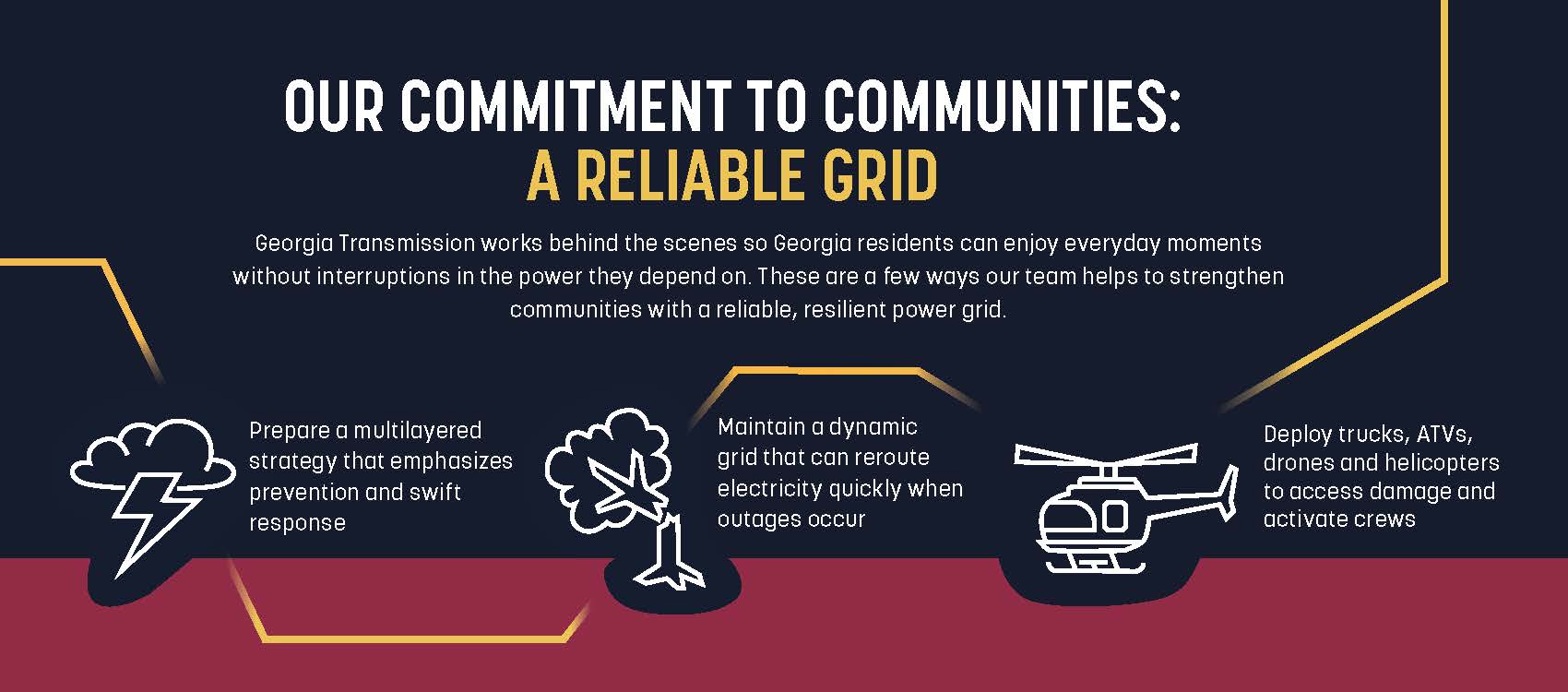A Resilient, Reliable Grid
Grid resiliency is the power grid’s ability to adapt to changing conditions, withstand potentially disruptive events and, if disrupted, to rapidly recover. Every year, Georgia Transmission invests millions of dollars and numerous hours planning, building and maintaining our transmission lines and substations. Through this investment in our grid’s resiliency, Georgia Transmission helps ensure the state’s power is more reliable than the national average. And, every year we raise the bar even higher.
Reliability performance is everyone’s responsibility at Georgia Transmission. Every year, a new standard of reliability is included in our corporate performance goals, making this continuous improvement a top priority for every employee. With this prioritized focus, we’re continuously exploring new innovations to help keep Georgia’s grid strong.
With each infrastructure project, we’re doing more than just building power lines — we’re making an investment in the continued prosperity of the communities we serve. Together with local EMCs, we safely provide access to the reliable, affordable energy Georgia needs to maintain a high quality of life and strong economic growth.
Maintaining the Grid Through Technology
In today’s world, having safe and reliable electricity at the flip of a switch is more than a nice thing to have — it is a necessity. While we can’t prevent every outage, our teams work every day to maintain our infrastructure, ensuring the system continues to reliably meet the needs of the communities we serve. We use two-way digital technology to monitor infrastructure, identify problems and often resolve them remotely. These innovations include fault detectors, remote-operated switches and lightning arrestors that quickly restore power and prevent outages.
Using aircraft-mounted sensors, including light detection and ranging technology, we survey our more than 3,500 miles of lines and verify they are functioning correctly. We also use X-ray technology to inspect line splices. An external inspection of these connection points doesn’t tell the whole story; by looking deeper we are able to ensure successful splices, preventing an unnecessary future outage. This technology allows us to keep our employees safe while ensuring Georgians have power when they need it.
Additionally, we are focused on being prepared for any new or revised reliability standard requirements. In 2021 alone, we implemented 131 new or modified mandatory standards related to functions such as grid security, cyber security incident response, facility interconnections, facility ratings, system modeling and disturbance modeling.
Maintaining Our Right of Ways
Managing vegetation growth near transmission lines is a crucial piece of Georgia Transmission’s efforts to maintain a resilient grid and reliable power supply. Overgrown vegetation around towers can limit our crews’ access for inspections and routine maintenance. Similarly, dying trees or low-hanging limbs can damage power lines, interrupt the safe flow of electricity and cause outages to homes and businesses.
Our proactive approach includes regular inspections to identify vegetation encroaching on our infrastructure before it causes a problem. To avoid power interruptions and other dangerous incidents, our teams work with landowners to address problematic vegetation, while also reducing soil compaction, erosion and sedimentation.
Investing In New Infrastructure
While maintaining current facilities, Georgia Transmission is also continually forecasting future infrastructure needs by studying grid activity during peak hours. We use this data to determine when we need to build or upgrade lines and substations to meet increasing demand.
In 2021, we completed 88 infrastructure projects and modifications, including five new substations and one new transmission line project, bringing our total facilities to more than 3,500 miles of transmission lines and 765 substations across Georgia.
With nearly $2.8 billion in assets today, we remain committed to maintaining and improving the link between Georgia’s energy generators and local electric cooperatives. And, with our $293.1 million capital budget for 2022, we’re making investments today to help ensure Georgia’s future stays bright for years to come.


